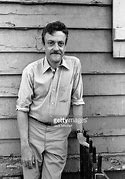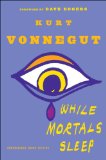All entries in this blog are freely submitted by members of the Kurt Vonnegut Book Club and are uncensored. Opinions expressed herein do not necessarily represent the opinions or positions of the Kurt Vonnegut Memorial Library, its staff, or its management.
Our determined little book club soldiered on with John Hawn, Phil Watts, Mark Hudson, Bill Briscoe, and Dave Young. Janet Penwell led us through a posthumous (2011) collection of KV’s Short Stories, “While Mortals Sleep.” We previously read this work in March, 2012.
If you are a short story writer and no magazine wants to buy your stuff, what do you do? In the 1950’s and 60’s KV made a decent living selling such stories to mass circulation magazines until that market dried up. He was left with several stories that didn’t sell including the sixteen that ended up in “While Mortals Sleep.” No fool when it came to marketing, KV ultimately packaged these turkeys with better stuff and sold it all as archival material to the Indiana University Library.
There isn’t much point in going through our discussion of each of these stories. A few of us liked some of the stories, but the overall reaction was “forgettable,” “creepy,” and “outdated.” These stories have more of an emphasis on women than we are accustomed to in KV’s work. That may have been because women were more likely to follow the mass magazines than men. His treatment of women was condescending by today’s standards and his stories are even less likely to be published today than they were 60 years ago. I have attached a favorable review which will give you the flavor of some of the stories.
The title story “When Mortals Sleep” (from lyrics to “O Little Town of Bethlehem” – “While Mortals Sleep, the angels keep their watch of wondering love”) is social commentary on what a travesty the observance of Christmas in America has become. Some of us were chilled when on page 125 (Dial Press) the cynical newspaper editor, observing that the news was slow, says “It’s about time somebody was running beserk with an automatic shotgun in a kindergarten, isn’t it.” Such thoughts used to be unthinkable.
About the only pleasure a hard core KV fan can extract from this compendium is the observation of KV’s craft. He is well known for setting the famous “mousetrap” which catches the reader by surprise. Unfortunately, in many of these stories the end comes rather abruptly without shedding any light. We cynically assumed that KV had run up to the limit of the word count that a prospective publisher would pay for and dropped the story then and there. Nevertheless, these stories were not found in a shoebox under his bed post mortem and we must assume that he deemed them complete before he included them with his archival material.
We gave this work a rather tepid 6.3 rating on the vaunted KV ten-point scale and the five guys then split for a hearty lunch at Acapulco Joe’s, a mere two blocks away from the Library.
On August 23, 2018, Dave Young will lead a discussion on Tom Wolfe’s 2004 Novel “I Am Charlotte Simmons” at the KV Memorial Library. Please join us at 11AM for 90 minutes of patter and, if you so choose, a chatty lunch afterwards.
Dave Young
**********************
from: Wikipedia
While Mortals Sleep is a collection of sixteen previously unpublished short stories by Kurt Vonnegut, released on January 25, 2011. It is the third posthumously published Kurt Vonnegut book, the first being Armageddon in Retrospect, the second being Look at the Birdie.[1] The book begins with a foreword by Dave Eggers. Illustrations by Vonnegut himself appear throughout.[2]
Contents
1 “Jenny”
2 “The Epizootic”
3 “Hundred-Dollar Kisses”
4 “Guardian of the Person”
5 “With His Hand on the Throttle”
6 “Girl Pool”
7 “Ruth”
8 “While Mortals Sleep”
9 “Out, Brief Candle”
10 “Tango”
11 “Bomar”
12 “The Man Without No Kiddleys”
13 “Mr. Z”
14 “$10,000 a Year, Easy”
15 “Money Talks”
16 “The Humbugs”
*******************************
From: The Washington Times Book Review
BOOK REVIEW: ‘While Mortals Sleep’
By Claire Hopley – The Washington Times – Friday, April 1, 2011
WHILE MORTALS SLEEP: UNPUBLISHED SHORT FICTION
By Kurt Vonnegut
Delacorte Press, $27, 272 pages
Until the 1950s, and even on up into the ‘60s and early ‘70s, a young unknown could sell a short story to a national magazine such as the Saturday Evening Post or Collier’s and get $750 or even $1,000 for it. For many, the first acceptance was a hallelujah moment: Writers such as Kurt Vonnegut gave up day jobs and relied on short stories for ready cash until a breakthrough novel catapulted them onto the literary scene.
In Vonnegut’s case, it was his 1963 best-seller “Cat’s Cradle” that did the trick. After that, and especially after “Slaughterhouse-Five” in 1969, he was a literary luminary until his death in 2007. But, his fame notwithstanding, many of his early short stories have never been published. In 2009, “Look at the Birdie” partially righted that. Now, a second volume, “While Mortals Sleep” presents another 16 stories.
They are old-fashioned tales: In his introduction, Dave Eggers calls them “mousetrap stories.” Their gotcha endings, often involving a twist, invariably leave readers with a lesson. The characters might also learn something, though often they are too set in their ways to apprehend their lives afresh. The title story is a good example. It’s a Christmas tale set in a Midwestern town, where the local newspaper runs an annual competition for the house with the most inventive set of Christmas lights.
The take-no-hostages city editor, Fred Hackleman, has no patience for this or any other Christmas celebration and, as the junior reporter assigned to the job of judging them discovers, cannot be moved, by either the most elaborate display or, apparently, the most affecting. He’s a hard man, and readers have no trouble realizing that they should neither be hard nor forget the real meaning of Christmas.
This story has everything it needs to become a Christmas classic: sharply drawn stock characters, including a curmudgeon, an ingenious ex-con and an ingenue reporter; imaginative and vividly drawn scenes; and, of course, a famous author. But with the exception of the latter – Vonnegut’s name – none of these would get it published today. The characters are simplified, and even the evocative descriptions would be unlikely to swing an editor in its favor. And the ending: It is definitely too sentimental, too moralistic and, frankly, too pat to satisfy the contemporary taste for the haunting, fine-tuned, short stories that are now standard.
Other stories in this volume share similar qualities. “With His Hand on the Throttle” tells of Hotbox Harrison, a successful young owner of a construction company “insistently at the center of any gathering.” He gets his jollies from his HO-scale trains in his basement, delighted to have “this much of the universe precisely where he would have it, under his thumb.” He’s always promising to take his young wife out, but it never happens. Even when his mother launches a pre-emptive wake-up call, he turns it to his own purposes.
Unwillingness to change is often the road to disaster. In “Jenny,” a brilliant engineer designs a fridge called Jenny. It has a foam-rubber face, and it can speak and move. By taking Jenny on the road and putting her through her amazing paces, he becomes his company’s ace salesman. But his obsession with electronics has limited his life and doomed his marriage.
Implicitly, these stories are a critique of the post-World War II syndrome of a working dad consumed by his job and a neglected or harried stay-at-home mom. The logical result of this system – now somewhat changed but still thriving – is described in “The Epizootic.” A smart insurance executive puzzles over the huge number of youngish men who commit suicide, leaving their widows and children well provided for by their life insurance.
Pondering the causes of this suicide craze, he sees that the proceeds of a life insurance policy may be the very best men can offer in a world in which they are judged – and judge themselves – by how much money they earn for their families.
The sadness at the center of these stories is that they are about loneliness usually created by some form of tunnel vision that withers the heart. Living a fantasy is just as limiting, as we see in “Hundred Dollar Kisses,” in which Verne Petrie claims he’d give $100 to kiss one of the sexy girls flaunted in soft-porn magazines, despite having a wife and children at home. More affectingly, in “Out, Brief Candle,” the widowed Annie Cowper confides in a pen pal, as he does with her. Soon, she is convinced that they are made for each other, but when she travels to find him in Schenectady, N.Y., she meets only tragedy.
At the end of this bittersweet tale, readers know a lot more about the pen pal than Annie does. Indeed, Vonnegut always makes absolutely certain that readers know where they stand. His stories appeal to our better selves, generally delivering wake-up calls. To respond to them is to feel good, and that was the charm of such tales in the heyday of the magazines that published them.
Today, they seem distinctly outmoded. Nonetheless, their taut telling, satiric zing and, yes, even those tidy endings often give them power. Scholars and other fans of Vonnegut’s work will applaud their publication – though they will wish that there were some notes indicating when he wrote each one and when he drew the line drawings that accompany them so effectively.
Claire Hopley is a writer and editor in Amherst, Mass.


